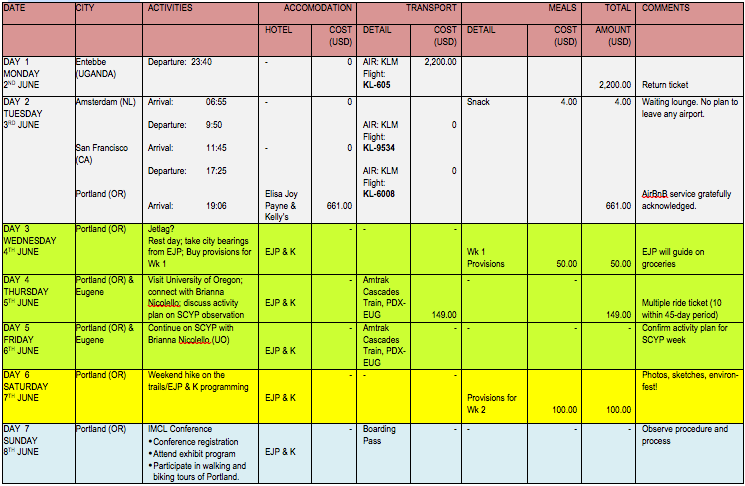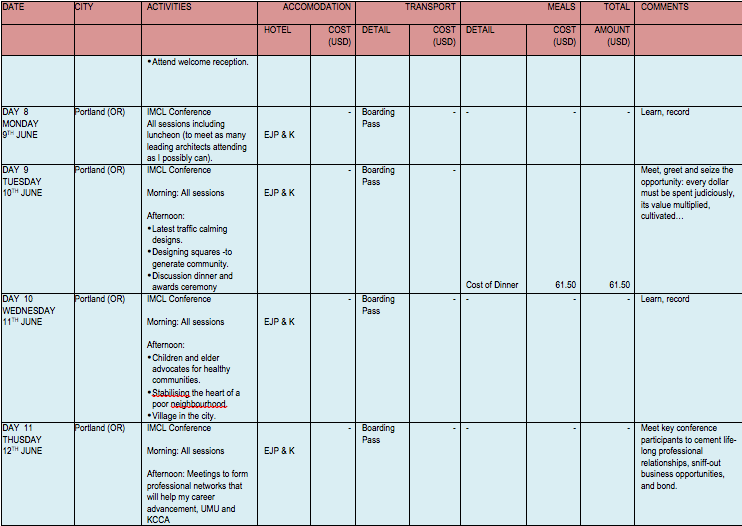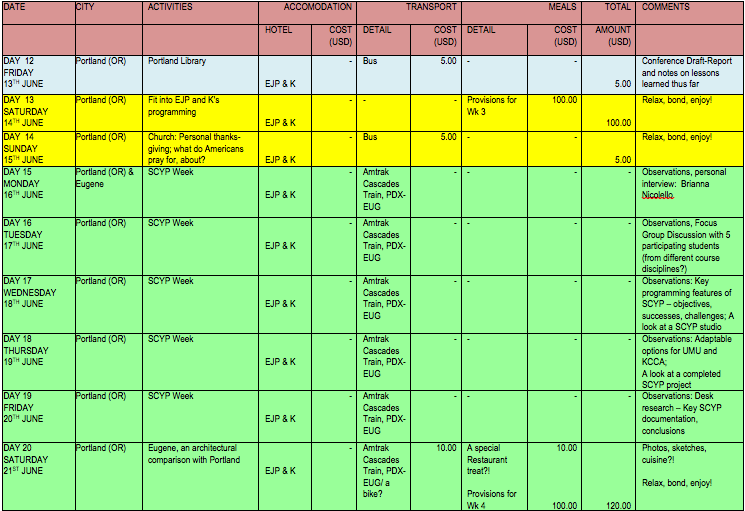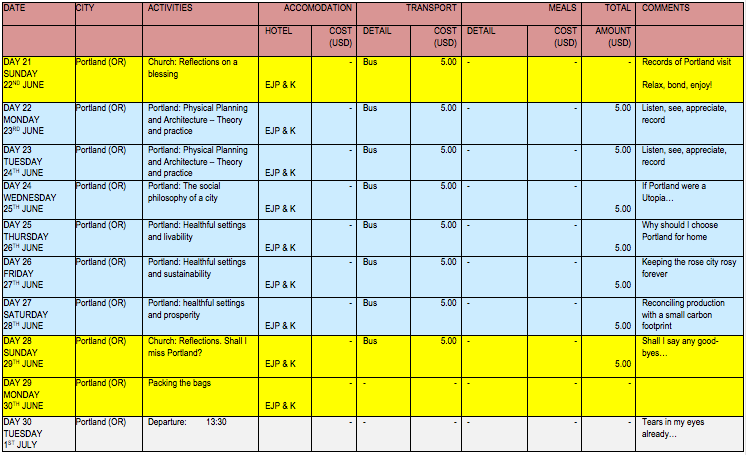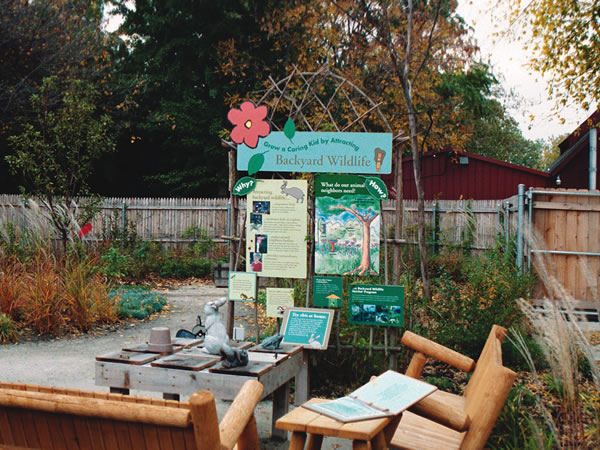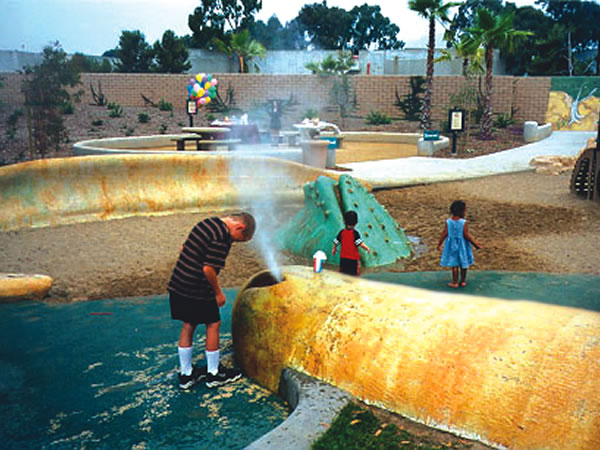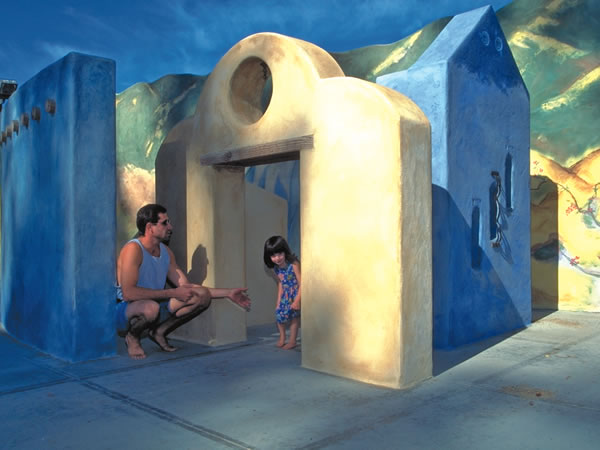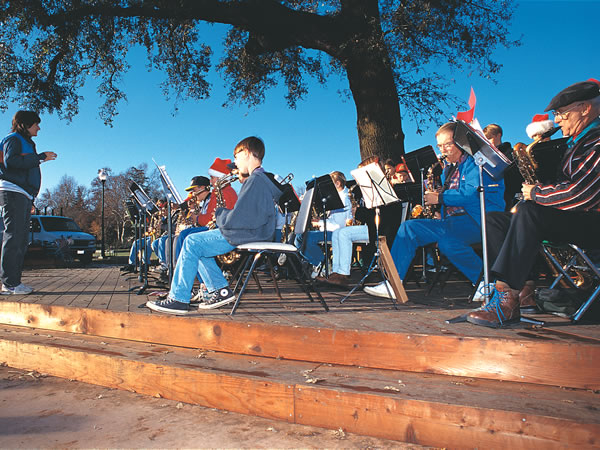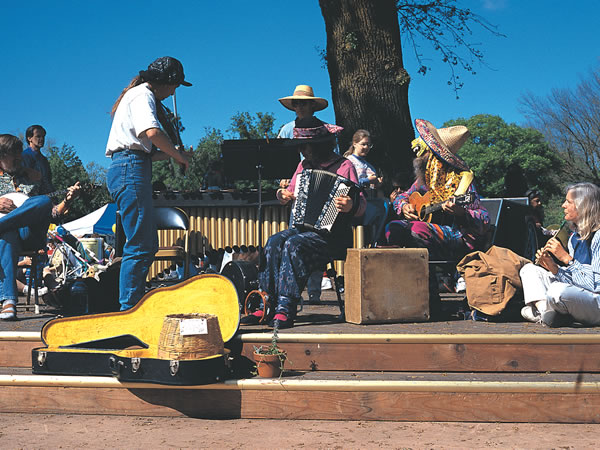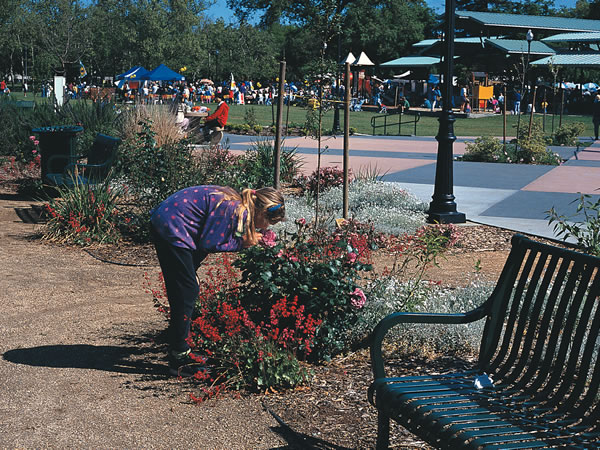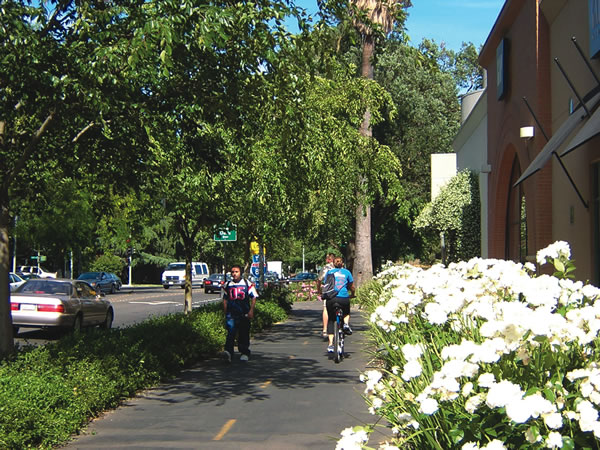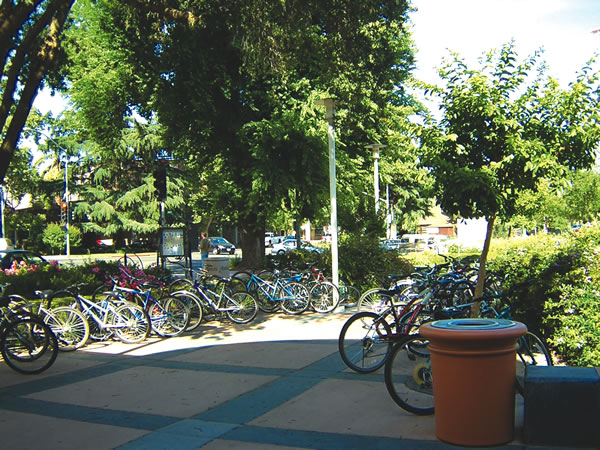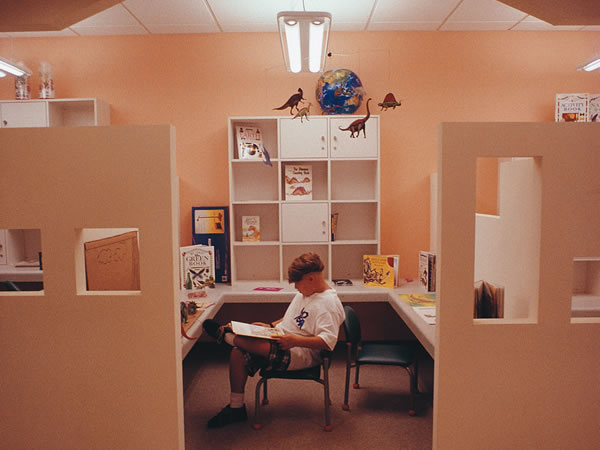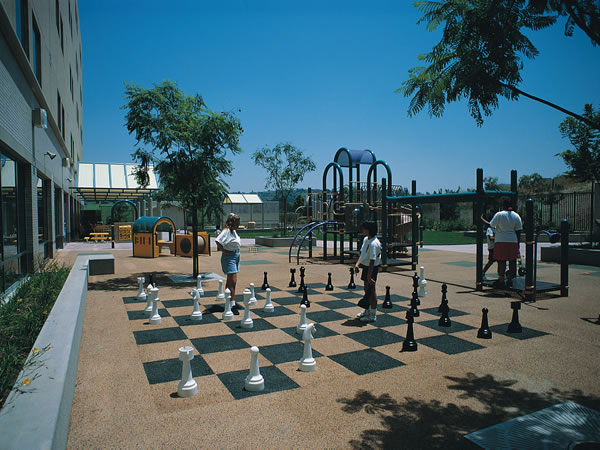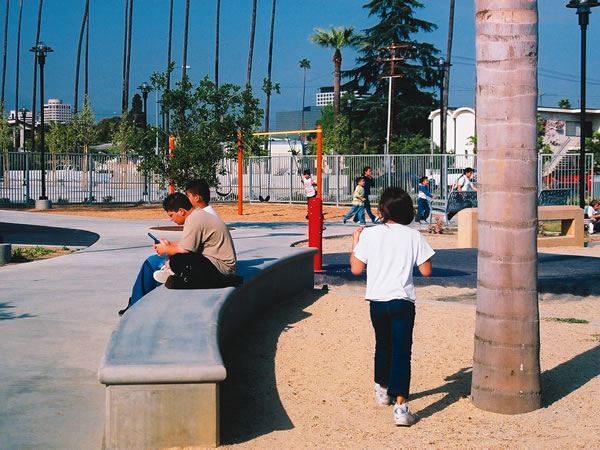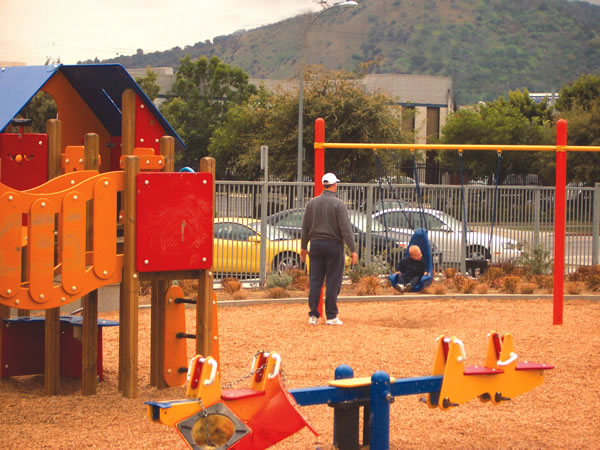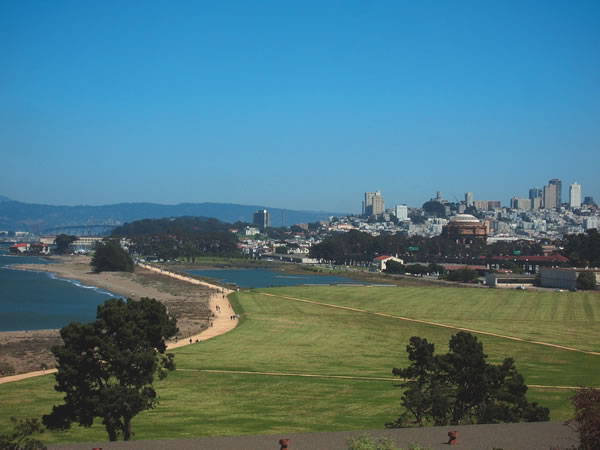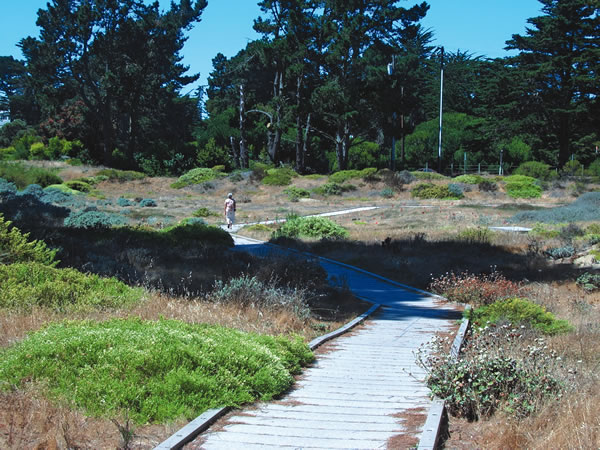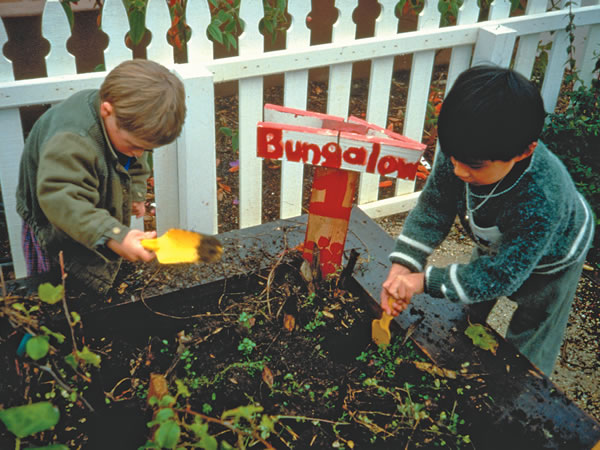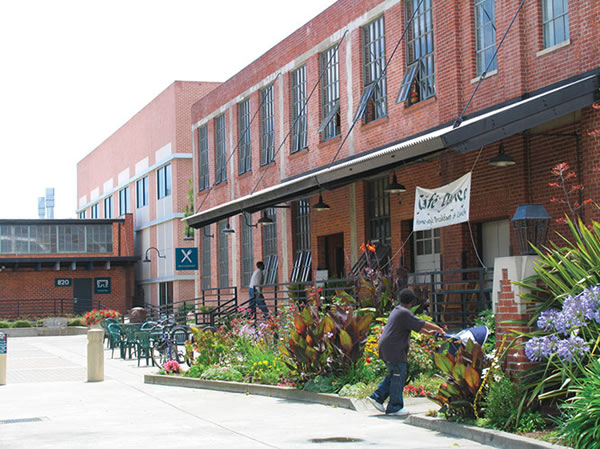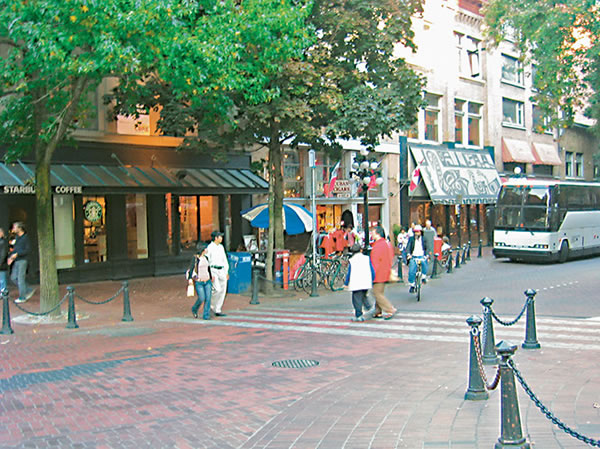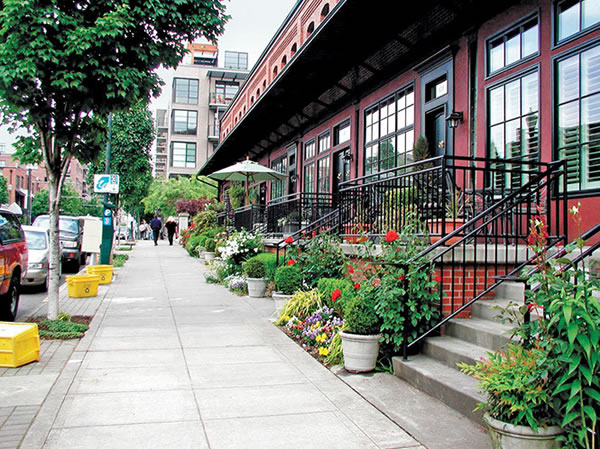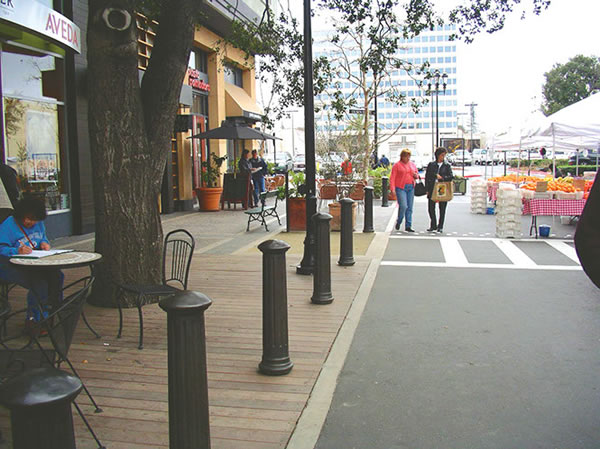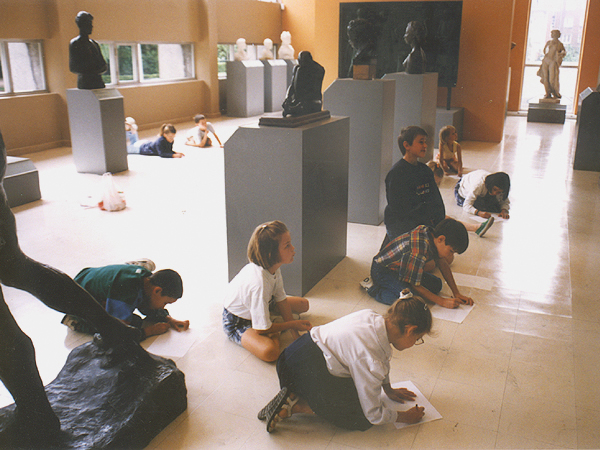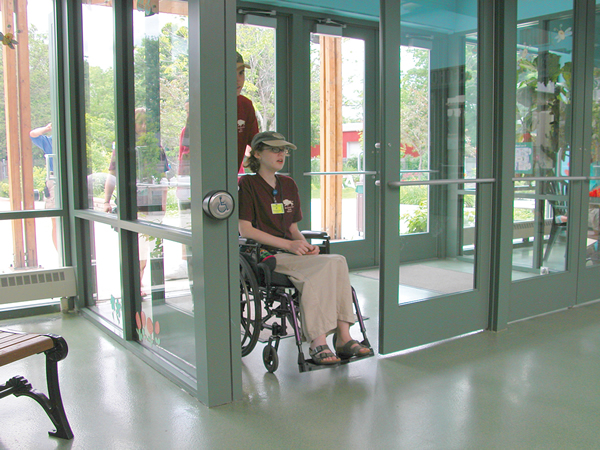Sheila Malingu Travel Fellowship ReportUSA, JUNE 2014
ADAPTABLE OPTIONS FROM THE “SUSTAINABLE CITY YEAR”
Acknowledgements The travel fellowship would not have happened at all without the vision of the Berkeley Undergraduate Prize for Architectural Design Excellence chaired by Professor Raymond Lifchez. For according me the rarest of opportunities open to any undergraduate at a Ugandan University, I remain eternally grateful to the BERKELEY PRIZE Committee. In addition, the following people variously guided me through the process and successful completion of my excursion in Portland and Eugene: Thea Chroman – BERKELEY PRIZE; Brianna Nicolello, Amy Cubbage and Dr. Bob Choquett – University of Oregon (SCYP); Professor Suzanne Crawhurst Lennard – IMCL; and Elisa Joy and Kelly Payne who opened to me the doors of their lovely home in Hillsboro and treated me as one of their own. Dr Mark Olweny, Associate Dean of the Faculty of the Built Environment at Uganda Martyrs University endorsed my participation in the competition with a kind recommendation. Finally, my parents Miriam and Charles Malingu spurred me on even when I appropriated the use of their computer for over six months of research and communication. Executive Summary This report is made to the BERKELEY PRIZE Committee as part of the requirements for the completion of the travel fellowship proposal titled “Adaptable Options from the ‘Sustainable City year’.” For the benefit of the other recipients of the report, an introduction of the Committee’s work follows. The BERKELEY PRIZE is endorsed by the Department of Architecture, University of California, Berkeley, USA. At their web page (http://berkeleyprize.org, 2014), the Committee state that the organization strives to show architects-in-training that the smallest act of building has global implications: that design can and does play a major role in the social, cultural, and psychological life of both the individual and society at large. In pursuit of this goal, the organization has been organizing the BERKELEY PRIZE Competition since 1998. The competition has two components for undergraduates: the essay prize and the travel fellowship. Both prizes involve cash awards made possible through a generous gift by Judith Lee Stronach to the Department of Architecture in the College of Environmental Design at the University of California, Berkeley, U.S.A. Adaptable Options from the “Sustainable City Year” responded to the 2014 competition theme, “The Architect and the Healthful Environment.” The proposal had four objectives namely, (i) to appreciate through direct observation the operational process of the Sustainable City Year Program (SCYP) at the University of Oregon; (ii) to participate in the 51st International Making Cities Livable (IMCL) Conference (2014); (iii) to share knowledge gained from the visit with built environment students in Ugandan universities through a workshop presentation at Uganda Martyrs University, Nkozi; and (iv) to report proceedings and outcomes of the fellowship to the Berkeley Travel Fellowship Committee. The proposal won an award of US$ 3,700 which was used to procure: (i) a round-trip ticket from Entebbe, Uganda to Portland, Oregon, USA; (ii) accommodation in Hillsboro, Oregon; (iii) bus and train fares around Portland and Eugene; and (iv) meals for 30 days. The fellowship lasted 30 days from June 2 to July 1, 2014, over which period 5 days were spent studying SCYP at the University of Oregon and in Springfield, 5 days attending the 51st IMCL conference at the Sentinel in Portland, 5 days on green spaces and sustainable, equitable neighborhood designs in Portland and 5 days in Gresham figuring out what Oregonians called informal settlements and what they were doing to formalize them. Over the weekends, the leisure spots at the Cannon Beach on the Pacific coast and the snow-capped Mt. Hood were explored. Findings from observations made in Oregon will inform the forthcoming “Adaptable Options” Conference at Uganda Martyrs University, Nkozi. Experiences from the travel fellowship to Portland and Eugene led to the following conclusions: (i) “houselessness”, the lack of access to adequate housing by any citizen, should be treated as a critical community issue with vast public costs; (ii) for sustainable urban development, the community should be involved in the planning process of places and spaces in its neighborhood; (iii) a square is no longer one if it is inaccessible to the community; (iv) a place should be designed and built to have a sense in itself, impart a feeling of intimacy to its visitors and be one to remember; and (v) transportation routes are vital arteries to sustainable healthful settings in the city and ought to be planned, designed and built with utmost care.
Background Adaptable Options from the “Sustainable City Year” responded to the 2014 competition theme, “The Architect and the Healthful Environment.” The Sustainable City Year Program (SCYP) is a program run by the School of Architecture at the University of Oregon. The university is located in Eugene, Oregon, USA. SCYP responds to real (as contrasted with hypothetical, academic) problems in different cities that surround Eugene. The students are asked to complete a task that is originally requested by a certain city. The sustainable student-generated designs that stand out are then implemented and put on ground. Cities are given a chance to apply in the September of the preceding year. In February of the next year, a city is chosen by the students. For an entire year, the city administration and the students work together to make a sustainable place. In the year 2013, Springfield was the lucky city whereas in 2014, Medford was matched with the students by Dr. Bob Choquett, the principal. For me, the connection between SCYP and the competition theme required a bridge: the Kampala-Portland contrast. On the one hand, there was Uganda’s Kampala, a naturally beautiful place that had become so damaged by unplanned human settlement and activity that ordinary, formal urban planning methods were constantly being superseded by wave upon wave of immigration and population growth. On the other was the Oregonian city of Portland, famed for its valiant and superlatively successful rise to the position of cleanest city of the world. The question was how could Kampala rouse itself and negotiate a way out of the tangle of unplanned mess where it had slid and slumbered for over four decades. Like a light house, Portland twinkled, assured as much in development direction as in current situation. I took my bearings. In Kampala, a network of civil society organizations called Shelter and Settlements Alternatives (www.ssauganda.org) had seen the possibility of leveraging the power of numbers from amongst the body of undergraduates of Architecture at Ugandan Universities but did not take their vision to its logical conclusion. The SCYP team at the University of Oregon seemed to have a similar vision, … “Cities often lack the funds and knowledge to implement innovative sustainability projects… college students have professional-level training and a need for practical work…” plus the heart and organization to see it through. The University of Oregon at Eugene was a stone throw away from Portland. I decided to go and observe Portland but learn my ropes from the SCYP team. I received a travel fellowship stipend of US$3,700.00 which was enough for US Visa fees, IMCL Conference fees, return air ticket from Entebbe airport (EBB) to Portland (PDX), accommodation, meals and transport expenses in Portland and Eugene for 30 days (see Appendix II: Financial Report).
Objectives The proposal had four objectives as outlined below.
Methods Three methods were used to realize the objectives. They included observation, interviews and attendance of conference workshops. I discuss these methods as they were used during my travels. Observation At the end of my first year at university, my year group on the Environmental Design course was required to travel throughout East Africa in teams of four, observe architectural works in at least 5 cities and write a report. We went around, enjoyed ourselves for about 2 weeks and made our mandatory presentations. When I set off for Portland on June 2, 2014 at the end of my second year, I was wondering how I would convert what I was about to see into useful concepts in my course of study and for Kampala (since that was one of my stated objectives). An obscure part of my mind kept tugging at my heart saying, ‘to simply see is not to observe.’ So by the time I touched down at Portland International Airport after nearly 30 hours of travel, 19 of which were in the air, I had willed myself not only to see but to feel and to understand. Still, I was too tired that first evening to do anything beyond surrendering myself to the gracious ministrations of my host, Elisa Joy Payne (EJ) of Hillsboro, Oregon. For 28 of the remaining 29 days, I always carried my camera with me as an “observation aid.” I touched things, chatted with people, visited parks and forests and even the pristine Mt. Hood and the majestic west coast off the Pacific Ocean.
Nonetheless, I started understanding the essence of observation of place only after reading Ulrich (2006) as I began to piece together this report. In the passage that I will quote from liberally, Ulrich himself is reviewing Alexander’s (1979) “The Timeless Way of Building”, both architects, I must add, being alumni of the University of California at Berkeley. In observing design, as now I am content enough to contend, there is a center piece whose existence we would wish to isolate and memorize for our benefit. Ulrich quotes Alexander (1979) describing this core as “… a central quality which is the root criterion of life and spirit in man, a town, a building, or a wilderness. This quality is objective and precise, but it cannot be named (Alexander, 1979, p. 19).” That central quality gives any built or un-built space its unique sense of place. Each observer will respond differently to a given space but, on the normal distribution curve, there will be agreement about its attraction, livability or sustainability. “The specific patterns out of which a building or a town is made may be alive or dead. To the extent they are alive, they let our inner forces loose, and set us free; but when they are dead they keep us locked in inner conflict” (Alexander, 1979, p. 101). The illustration that follows cannot leave any keen observer in doubt. Ulrich invites us to see a design pattern as a way to solve a specific problem of design. Basically, a design problem arises when a situation involves two conflicting forces that are not properly balanced. For instance, when a room has a window on one side and a sofa corner and TV place on the other side, people tend to feel uncomfortable, for they are unable to balance two conflicting goals: they wish to sit down (so as to make themselves comfortable and to read, talk to one another, or watch TV) while at the same time, they wish to be close to the window (so as to look out, see the view, and enjoy the sun light). Once we have understood the nature of the problem, we can resolve it easily by moving the sofa corner and TV close to the window. This immediately creates a “place” where people feel comfortable to stay. Alexander calls it a “window place” – a basic pattern that everyone can experience and apply at home. As a rule, a room that does not have a window place lacks quality; its windows are just holes in the wall. If the windows are just holes in the wall, and there are no places where the windows are, one force pulls me towards the window; but another force pulls me toward the natural ‘places’ in the room, where the comfortable chairs and tables are. So long as I am in this room, I am pushed and pulled by these two forces; there is nothing I can do to prevent the inner conflict they create in me (Alexander, 1979, p. 112). Alas, I have to admit that I, in a blind daze, stumbled through the beautiful streets, gardens and squares of Portland! But Ulrich removes the scales by exposing “observation” substantially enough for me to understand that I indeed observed Portland and the SCYP program at the University of Eugene, the results of which I discuss shortly. I shall need the services of a very clear hind sight, a sharp ear and the recordings of a faithful camera to craft a sensible, coherent picture. Interviews The interviews were informal discussions with the people who were the best placed key informants on the subjects at hand. I spoke directly with Professor Crowhurst Lennard, the founder and convener of the IMCL Conferences. I also had audience with Ms. Brianna Nicolello and Dr. Bob Choquett of SCYP. Then, especially amazingly because she had to put so many other things on hold to be my guide, Elisa Joy showed me around Portland. Workshop sessions Finally, I attended the plenary sessions and group discussions of the 51st IMCL Conference at the Sentinel, at the feet of the most respected, most illustrious architects gracing any city today.
Discussion In my travel fellowship proposal the thesis of healthful settings was one with the following characteristics: (i) access to safe water, (ii) access to sanitation and other infrastructure, (iii) secure residential status which could be translated as universal access to shelter, (iv) high structural quality of housing, and (v) adequate per capita space. Portland, Oregon, has all these and more. The discussion has long moved away from these basic urban needs to a postulation of the principles of true urbanism. I willed myself to make the quantum jump in perception of what would be good for Kampala. The 51st International Making Cities Livable Conference (IMCL) 2014 IMCL defined a 4-part strategy to propagate the principles of true urbanism: (i) facilitate community social life; (ii) facilitate access to nature; (iii) facilitate independent mobility; and (iv) create a hospitable built environment (Crowhurst Lennard, 2014). (i) Community life creates a “social immune system” that buffers stress, improves coping and protects health (Crowhurst Lennard 2014). As such, architects are enjoined to build for human contact, building surroundings that invite meeting and centers that shape meeting. Architects in Kampala have the natural spaces that could be designed to look like the public space in Figure 4. Instead, we are complicit to the construction of access impediments as in Figure 5.
Public places enhance community life by being hospitable, harboring beloved features and conveying a sense of place. Hospitality may be in the form of different kinds of seating that allow people to sit together and talk, sit alone in the sun or shade, listen to bees buzzing in the flowers, or listening to occasional music… any good thing to keep the citizen healthy while the architect designs and constructs the next healthful setting (see Figures 6 and 7).
(ii) Access to nature in the city improves the health of the citizens. Nature need not be restricted to parks and playgrounds but should be an integral part of every neighborhood… In Portland, the Rose Festival Dragon Boat Race (Figures 8 and 9) makes themes out of serious public questions and then designs solutions that encourage the public to contribute through leisure activities in natural settings. Natural settings could be introduced as a key theme in the powerful idea of the Kampala Festival enunciated by KCCA executive director Jenipher Musisi.
(iii) Independent mobility depends on, and ultimately becomes a measure of the safety of the street. Paving designs and textures help children who are close to the ground as well as the elderly and the blind to find their way around. When children are able to walk to school and around their neighborhoods without the constant threat of a traffic accident, the city planner can then sit back and polish up on the aesthetics. A possible area to start with in Kampala is the establishment of bike lanes which can be easily accomplished by a lick of paint (see Figure 10).
(iv) A hospitable built environment in the city has human scale architecture, is integrated and has a neighborhood square. Human scale architecture means that buildings are no higher than five stories, the height at which it is possible to identify a face at the top window or call down to a child in the street. Integration implies mixed income housing neighborhoods which do not segregate the poor and the wealthy, a requirement if we are to retain our humanity. Neighborhood squares are places everyone in the city can freely use. If it does not serve this function, it is no longer a square. The Sustainable City Year Program (SCYP) My visit to the University of Oregon was divided into 3 parts with the following goals: (i) acquaintance with people and place at the School of Architecture; (ii) learning the SCYP process; and (ii) field experience of SCYP objects. The 5 days of SCYP excursion were guided by an itinerary agreed with Brianna (Bree) Nicilello and it reflected the plan to achieve the goals (see Text Box). (i) Meeting the people behind SCYP: On 5 and 6 June, 2014, I met Dr. Bob Choquett, Dr Nico Larco, Dr. Marc Schlossberg and Ms. Brianna Nicolello of SCYP. I attended two presentations and interacted with students of Architecture on the SCYP program (see text box).
There are two different outcomes perspectives of SCYP – the students’ view and the city view. Both are relevant to this type of community-engaged teaching and scholarship. Students report the following benefits from participation in SCYP: 1. Leadership Opportunities: Students are challenged to work closely with real clients; these opportunities build professionalism and develop confidence. 2. Addressing Real-World Issues: Students consider the impact of ideas present in their disciplines on real communities. They expand theoretical concepts beyond the classroom to consider a broad array of potential implications, and they develop an understanding of the complexities and requirements involved in civic projects. 3. Access to Professionals: Students work with city staff, local professionals, elected officials, and community leaders; many students form professional relationships that can lead to job opportunities after graduation. 4. Interdisciplinary Education: Students have the chance to experience and work on projects integrated across disciplines. Their work is informed by the richness of collaborating with their peers, and they develop new perspectives by working with students outside of their own disciplines. A representative city view is that in terms of sustainability, cities are trying to reverse course on 70 years of development patterns and public policy that supported land-use sprawl, automobile-dominant transportation, and a different mix of industry and economic activity than is the norm today. Reversing course for communities will not happen immediately just because of student involvement, but students can accelerate change and alter the basic policy, plans, ideas, and framing that cities use to guide all future activities. Conclusion Looking at Portland and how livable it is, it is simply amazing to see the plans they have for making “the Rose City” more livable. In Crowhurst Lennard’s words, “... if we want to make our cities livable for all, we must first make them healthy for the more vulnerable – the children, elders, the disabled and the poor…” Places like the Centenary Park in Kampala are our common wealth. They should not be parceled into business enterprises that interfere with accessibility but should instead be designed to make it possible for people to come together to form friendships and face-to-face social networks, develop social capital and community.
References Alexander, C. (1979). The timeless way of building. New York: Oxford University Press. Ulrich, W. (2006). The art of observation: Understanding pattern languages – A review of Christopher Alexander’s The Timeless Way of Building (New York, Oxford University Press, 1979). Journal of Research Practice, 2(1), Article R1. Retrieved 18th August 2014, from http://jrp.icaap.org/index.php/jrp/article/view/26/46 Crowhurst Lennard, S.H. (2014). True Urbanism. Principles for Making Cities Healthy for All. Portland: 51st IMCL Conference, Portland Oregon, June 8-12, 2014. Appendices Appendix 1: Travel Fellowship Proposal Adaptable Options from the “Sustainable City Year” “And these enemies too, poverty, disease and ignorance – we shall overcome.” (Lyndon B Johnson, President of the United States of America; March 15, 1965). Kampala City is suffering under the yoke of informal settlements. Recently, a nation-wide high circulation newspaper “The New Vision” harangued Kampala residents, “… you live in a slum; yes you do!” A few days earlier, the Ministry of Housing and Urban Development had reported that between 49 and 64 percent of Uganda’s urban dwellers lived in slums. The ministry, in agreement with UN-Habitat, had gone on to define slums as neighborhoods with the following characteristics: (i) inadequate access to safe water, (ii) inadequate access to sanitation and other infrastructure, insecure residential status, poor structural quality of housing, and overcrowding. In other words, the slum – Kampala’s most popular human habitation – is the antithesis of healthful settings. In many parts of the city the situation is so dire that, for example, deprived residents have invented a notorious sanitary vehicle called the “flying toilet” in place of the little affordable traditional latrine or the water-borne toilet. Its most developed variation has a thin polythene dome inflated with waste, flying blindly through narrow alleys in the total darkness of night. In these places prevalence of treatable diseases is high; the sick are unable to drag themselves out of poverty through employment; and the poor cannot afford education: neither for themselves nor for their children. Disease, poverty and ignorance are an ever present mortal enemy lurking in the shadows of every informal settlement in the city, waiting to strike. In a conscious effort to attract the attention of the built environment professionals towards designing sustainable neighborhoods, a network of civil society organizations in Kampala, called Shelter and Settlements Alternatives (www.ssauganda.org), organized an affordable shelters design competition for built environment undergraduate students from Makerere University and Uganda Martyrs University, Nkozi. That was in 2013 and the effort was for just that one year. The designs, having been duly exhibited, were tucked away by the conscientious organizers. This competition had the capacity to showcase young talent and open up opportunities for both the next generation of the built environment professionals and the city administration: opportunity in the job market for the students; and opportunity to access technical expertise from the universities at very little cost by Kampala Capital City Authority (KCCA). This vital partnership has not been realized yet. In their “Sustainable City Year Program” (SCYP), the University of Oregon have stated this same problem this way… “Cities often lack the funds and knowledge to implement innovative sustainability projects… college students have professional-level training and a need for practical work…” SCYP is enabling cities to reach their sustainability goals in an affordable manner while transforming higher education into an arena where students can learn through real-life problem solving. This initiative has useful lessons for built environment faculties in Ugandan universities as well as for KCCA. This travel fellowship proposal is for a gap-bridging visit to Portland, Oregon, one of the cleanest, most livable cities in the world with three objectives: (i) to appreciate through direct observation the operational process of the Sustainable City Year Program (SCYP) at the University of Oregon; (ii) to participate in the 51st International Making Cities Livable (IMCL) Conference (2014); (iii) to share knowledge gained from the visit with built environment students in Ugandan universities through a workshop presentation at Uganda Martyrs University, Nkozi; and (iv) to report proceedings and outcomes of the fellowship to the Berkeley Travel Fellowship Committee. Objective (i): To appreciate SCYP is to understand a development paradigm that addresses competing alternative economic policy issues for a city like Kampala which is grappling with a restrictive budget: funding consultants with the right expertise for city planning while arresting runaway unemployment among highly educated young people vis-à-vis infrastructure rehabilitation and development including ridding city streets of ditch-size potholes, procuring drugs for congested public health centers, and constructing and furnishing classrooms for an overwhelmed universal primary and secondary education program among many others. This objective will be met through contact established with Dr. Bob Choquett, the SCYP program manager. The budget for this objective is as follows: (a) Return Air Ticket (EBB-PDX-EBB) = US$ 2,174.00 (Brussels Airlines/United Airlines); (b) Internal Travel (Portland-Eugine-Portland) and others = US$ 250.00 (Amtrak Cascades); (c) Meals for 20 days = US$ 400.00; and (d) Accommodation in Eugine for 20 days = US$ 480.00. Total = US$ 3,304.00 Objective (ii): To participate in the 51st International Making Cities Livable (IMCL) Conference (2014) is to get the rare opportunity to listen to, exchange ideas with and learn from the leading proponents of sustainable healthful cities such as urban designers, planners, and public officials from North America and Europe. A discussion on adopting equitable planning, architecture and urban design priorities has been particularly emphasized by Dr Crowhurst Lennard, the Director of IMCL Council. The budget for this objective is as follows: Conference Registration Fees (Student-Non Presenter) = US$ 195.00 Objective (iii): To share knowledge gained from the visit with built environment students in Ugandan universities will be the first firm steps towards creating a generation of built environment professionals who are aware of and prepared to make a stand for the need of healthful, livable settings within the cities and in the countryside. The budget for this objective is as follows: (a) Sundry stationery = US$ 20.00; (b) Computer and LCD projector hire = US$ 30.00; (c) Main hall hire (3 hours) = US$ 30.00. Total = US$ 80.00 Objective (iv): To report proceedings and outcomes of the fellowship to the Berkeley Travel Fellowship Committee is an accountability issue. It is to recognize the universality of our responsible utilization of every resource in our trust, whether natural or manufactured. Above all, however, it will be an opportunity to express a profound gratitude using an appropriate medium. The budget for this objective is as follows: Electronic archival media (mass storage hard disk) = US$ 120.00. Grand Total = US$ 3,699.00 Appendix II: Financial Report Accountability summary
Appendix III City Year Program (SCYP) Report 1. SCYP Summary (UO) Sustainable City Year Program (SCYP) is a program run by the School of Architecture at the University of Oregon. The university is located in Eugene, Oregon. SCYP is a response program to the problems in different cities that surround Eugene. The students are asked to complete a task that is originally requested by a certain city. The sustainable designs that stand out are then implemented and put on ground. Cities are given a chance to apply in the September of the preceding year. In February of the next year, a city is chosen by the students. For an entire year, the city administration and the students work together to make a sustainable place. In the year 2013, Springfield was the lucky city whereas this year, Medford was matched with the students by Bob Choquett, the principal. The ideas from which the best are chosen are done by both the city and the faculty. This helps create a client relationship. Medford and SCYP signed a contract last year and during this process they decided on an amount that Medford city had to pay to the SCYP members. The funds that the city pays are used by the students to conduct visits to the site and also get all the necessary equipment required for the project. The funds keep the program running. SCYP has existed for six years. At its start, there was only one project available. By the end of the year, there were more than twelve projects being conducted by SCYP. The students that participate in this program are from different years. This depends on their student majors. However, most of them are from the 3rd or 4th year of study or graduated. Some of the projects that have been worked on are libraries, city halls, schools, play stations and fire stations among others. This year, Medford requested SCYP to design fire stations for the city. Six to eight students worked on one of the four stations. A review was done at the beginning to find out what the fire men need. At the end of the project, a review is given when presenting the design ideas. The students like the idea of the SCYP because they have a chance to connect and design for someone that actually exists. Students from other faculties also get a chance of involvement in SCYP. Some of these include Journalism (for public relations), Planning, and Economics (for data analysis) among others. GIS systems are also included to analyze maps. Appendix IV: 51st International Making Cities Livable (IMCL) Report Not yet available Appendix V: Proceedings from the Adaptable Options (A-Options) Conference Not yet available Appendix VI: Pre-travel Planning Adaptable Options Itinerary
Additional Help and InformationAre you in need of assistance? Please email info@berkeleyprize.org. |
|




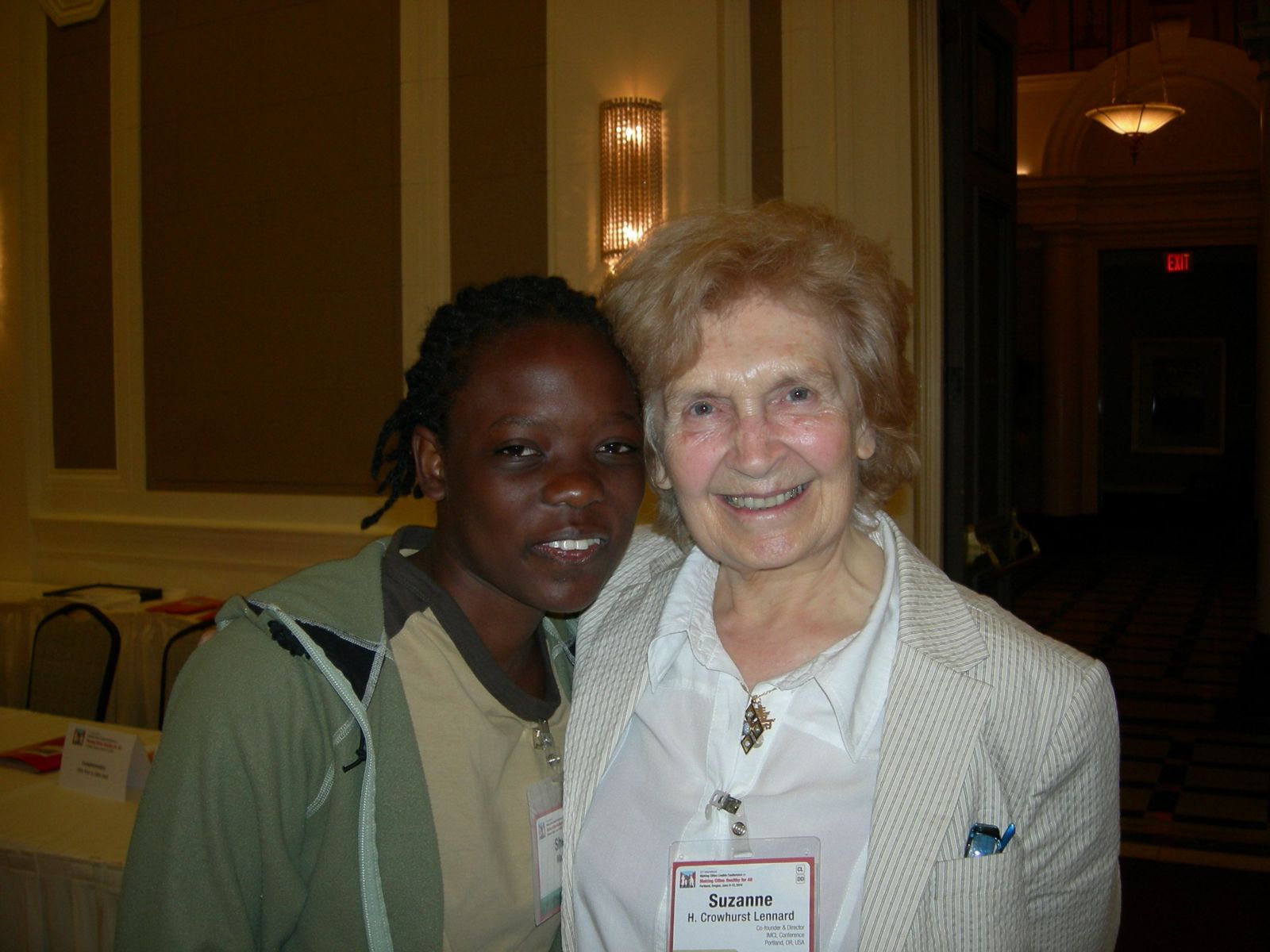
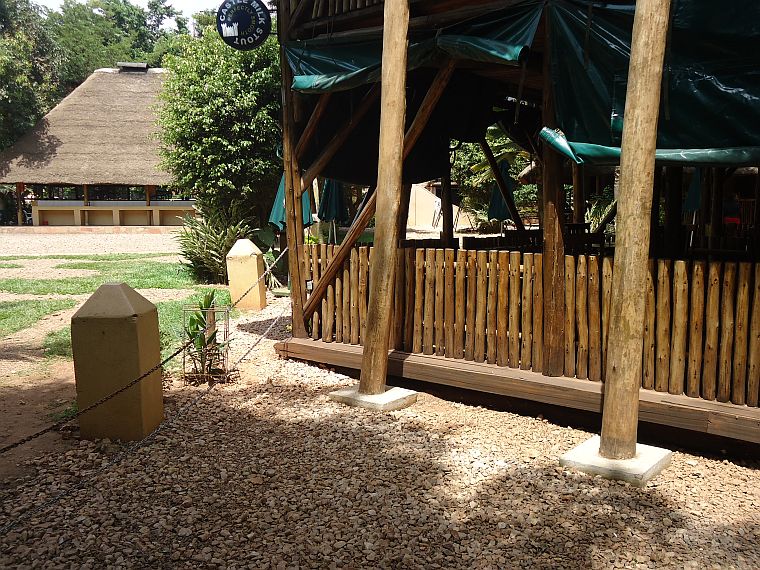
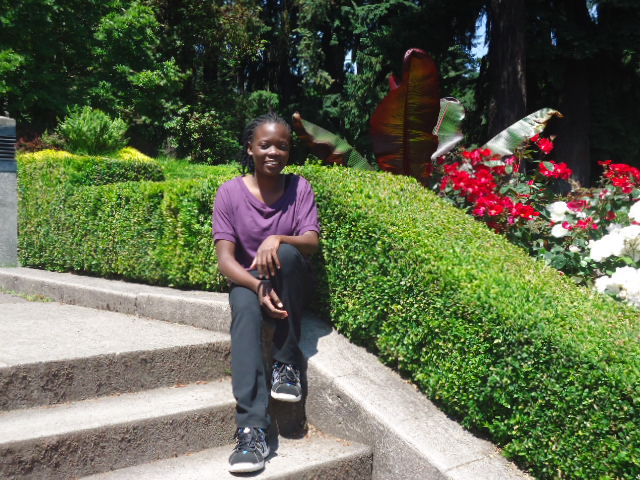
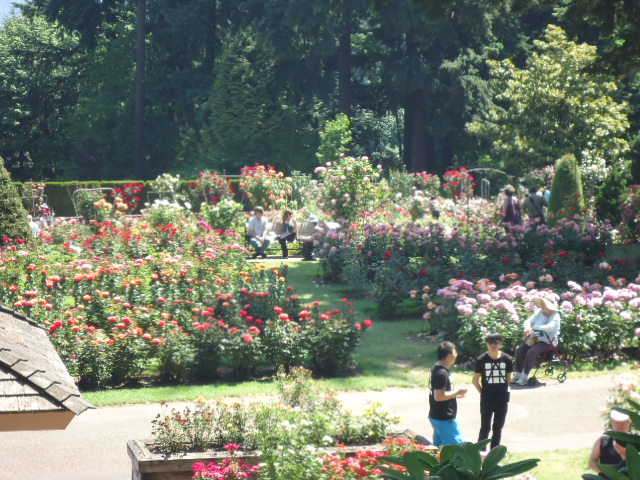

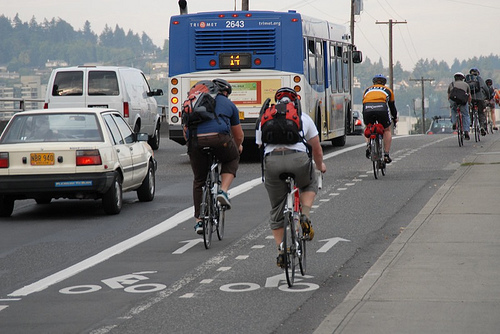
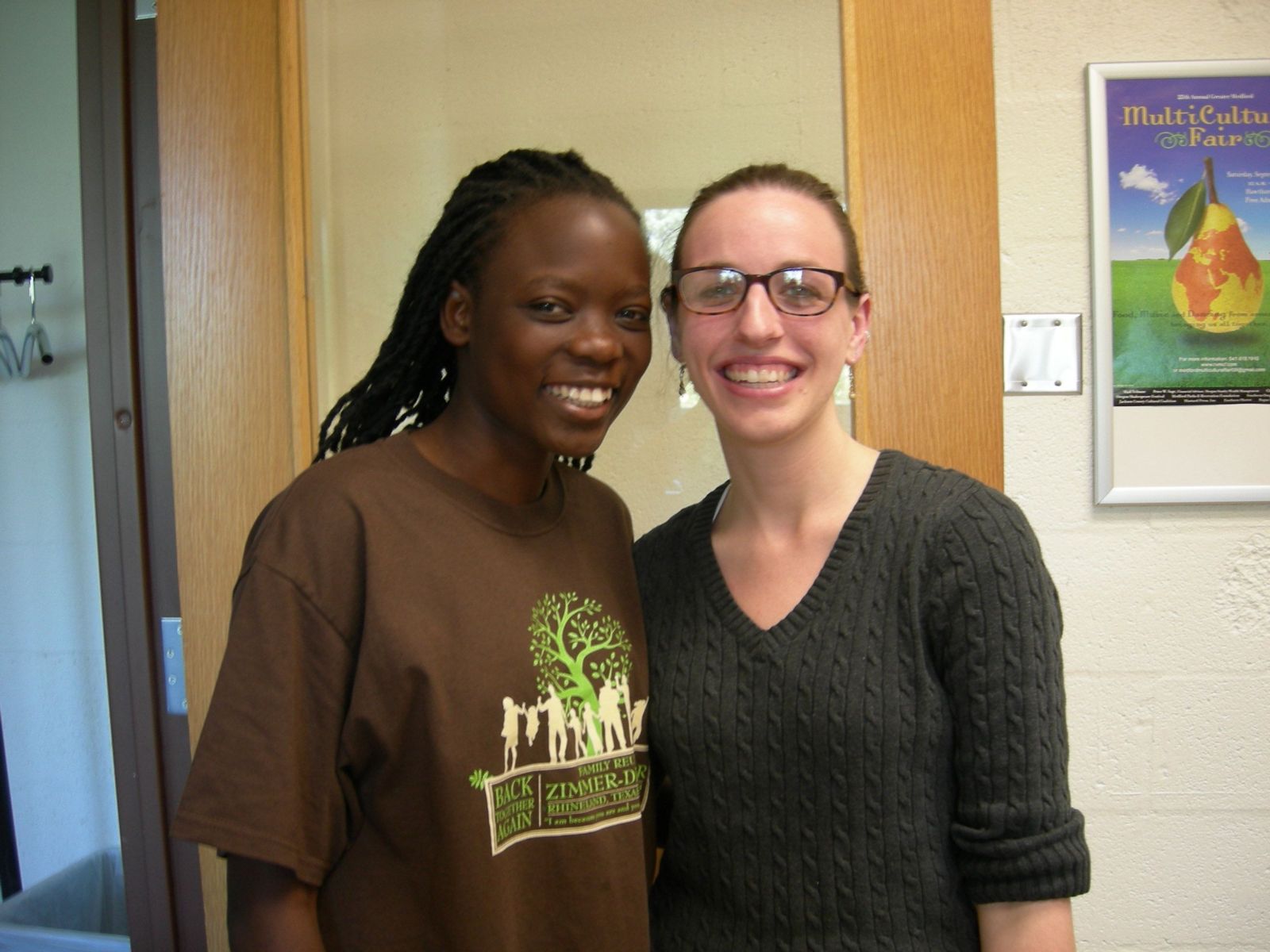
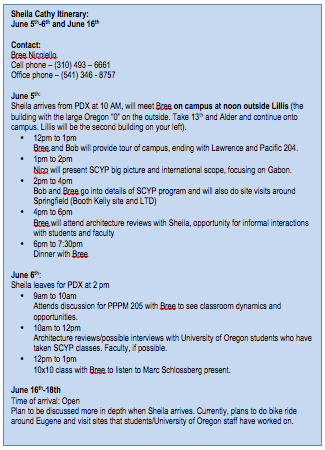 (ii) The SCYP Process: In summary there are steps a given city goes through to be accepted as a SCYP partner: (a) the city applies and is accepted to the program; and (b) the various members of faculty involved with the program express interest in working with the city. Throughout this process, SCYP staff and university leadership along with city staff and municipal leadership work to pair individual faculty with their counterpart in the city to define and refine projects that can be meaningful for the city and appropriate learning opportunities for students. The instructor and city staff person define scope, schedule, and deliverables and continue working together until their project is complete.
(ii) The SCYP Process: In summary there are steps a given city goes through to be accepted as a SCYP partner: (a) the city applies and is accepted to the program; and (b) the various members of faculty involved with the program express interest in working with the city. Throughout this process, SCYP staff and university leadership along with city staff and municipal leadership work to pair individual faculty with their counterpart in the city to define and refine projects that can be meaningful for the city and appropriate learning opportunities for students. The instructor and city staff person define scope, schedule, and deliverables and continue working together until their project is complete.